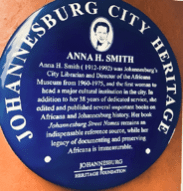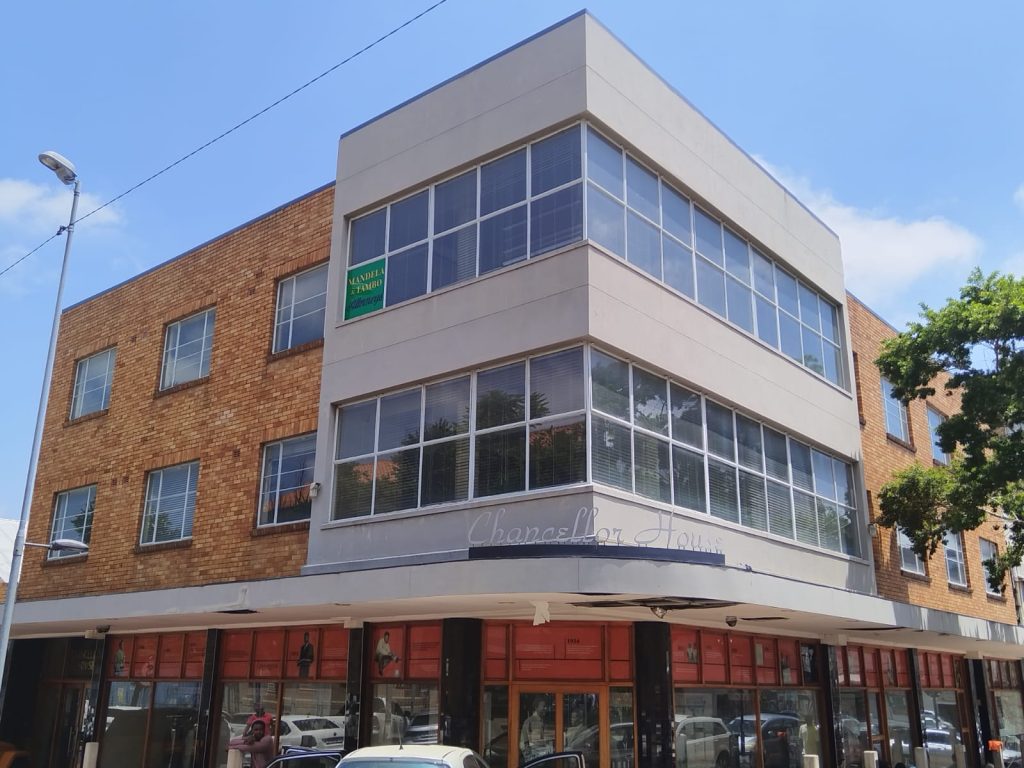The architectural style is Italian with modern tendencies in detail, combined in a stately building, well-proportioned and dignified. The Library stands in strong and harmonious relation to the City Hall to the east of what was Market Square.
As noted by R.F. Kennedy:
“An ideal library building provides the entrance at street level; steps are difficult for elderly people and should be avoided. In designing the library on the western, the lower, end of Market Square, it was necessary to give the Library height, in order to balance the City Hall at the other end of the Square. Had the ground floor of the library been at street level, the building would have appeared too squat in relation to the City Hall, hence the necessity for building the ground floor several feet above street level and for the provision of front steps, which have been a nuisance for these past thirty-odd years”.
The exterior walls are of a warm freestone from the flatpan quarries in the Orange Free State. The abstract treatment of the carved arches over the three storeys above the entrances can be traced back to the public library in Boston, which also has the general block form employed for the Johannesburg library. The legend “LIBRI THESAURUS ANIMI” (meaning “Books are the treasure house of the mind”) is carved prominently above the arches.
Other decorative features include:
Internal spaces are distinguished by large high-ceilinged rooms with impressive volumes. The fabric shows the use of rich materials – including decorative features of moulded coffered plaster, decorative wood-carvings and marble floors and pillars in the foyer.
Among the special collections is the Harold Strange Collection of African Studies, now housed on the top floor. A renowned collection on Southern African history and culture, it includes rare materials on Johannesburg history, Anglo-Boer War, ethnology, African languages and literature, and maps of Africa from the 15th to 20th century.
Other collections housed at the City Library include: the research-oriented specialist Children’s Book Collection; the Art Collection (including the Michaelis Art Collection and the Performing Arts Collection); the Reference Collection (including the Newspaper Collection and the Young Adults Reference Collection); and a Lending Collection aimed at all ages and interests.
The ground floor, with its impressive marble pillars, moulded ceiling and stained glass window, accommodates the Lending Collections for Children, Youth and Adults, the Main Reference Collection and the Young Adults Reference Collection. Above this, the second floor houses the Arts Department, comprising the Michaelis Art Collection, and Performing Arts Collection. The top floor holds the Harold Strange Collection of African Studies as well as the specialised Childrens’ Book Collection that includes the original Mavis Anderson Collection.
The basement includes the Newspaper Reading Room, as well as the reconstructed theatre. Beneath the Library, extensive underground stacks hold about 40 km of shelving for books, bound newspaper volumes and other stored collections.
The Johannesburg City Library opened in 1935 and is the successor of two earlier buildings – the corrugated iron Old Church Building used from 1893 to 1898, and the Kerk Street Library opened in 1898 which both stood on the same site in Kerk Street.
In the early years, the library was a subscription only facility. After the Anglo- Boer War, the Library continued to rely for revenue on subscriptions, donations and fund-raising activities, together with two annual grants – one from the Town Council and the other from the Transvaal Province. The depression of the 1920s brought an end to Provincial aid, and in 1923, despite some fierce opposition, subscribers agreed to transfer the library to the Town Council, so that it could become a free lending facility. Now a municipal institution, this became the first major public library in South Africa to do away with subscriptions.
The present library building was constructed on Market Square (now Beyers Naude Square) from 1931-35. The building was officially opened on 6 August 1935 by the Governor-General, the Earl of Clarendon.
The design, by the Cape Town- based architect John Perry, was the winning entry from an architectural competition which attracted 46 proposals. With Perry continuing to live in Cape Town during the construction, the Johannesburg architect A.J. Marshall was appointed resident architect to attend to issues on the ground.
The development was beset with disagreements and controversy, with Chief Librarian S.B. Asher having many differences with the architects. As noted by R.F. Kennedy in The Heart of the City:
“The erection of a library is always fraught with difficulty, the difficulty of reconciling the practical, administrative requirements of the librarian with the aesthetic requirements of the architect … Relations between the Librarian and the architect for the Market Square building were never cordial…”
The building was designed almost solely for library and museum purposes (the top floor was later occupied by the Africana Museum for many years). The one exception was the presence of a theatre in a library. Included in the design was a small auditorium intended as a lecture theatre in the semi-basement. This theatre was called a Lecture Hall because under the Local Government Ordinance there was no provision at that time enabling municipalities to establish or run a theatre. Nonetheless, this soon developed into an active playhouse, becoming one of the city’s foremost venues, and was for some years the only theatre in Johannesburg.
The Theatre became the home of the Library’s Technical Services division in 1984/5. More recently, the Theatre was reinstated as part of the restoration work carried out in 2009-2011.
Excavations to create an underground book stacks beneath the library building were begun in 1965. This was linked to the construction of the Harry Hofmeyer Parking Garage) beneath the Library Gardens (now Beyers Naude Square).
In 1995, the museum collections of Africana and Geology were relocated from the library (moving to MuseuMAfricA in Newtown). The top floor then became available for the Art and Music collections that had been housed for many years in the nearby Elizabeth House in Pritchard Street.
A major building and restoration project was undertaken in 2009-2011, with city funding in support of a substantial grant from the Carnegie Corporation of New York towards the upgrading of collections and the database / catalogue. This involved the renovation of the historic 1935 building, as well as the construction of a three-storey addition in the central courtyard, linked by escalators and bridges to the original building. The new floors, together with the addition of mezzanine balconies with study space above the reference and lending areas add to the usable space. Two new lift shafts were introduced, and the existing lift shaft was increased in size to accommodate a bigger lift car. New plumbing, electrical services, fire safety and information technology systems were integrated within the historic building.
More recently however, a leaking roof, structural damages, problems with the fire protection system, and issues with the drainage system made the Johannesburg City Library unfit for use, and the facility remained shut to the public from 2020 onwards. Together with other civic society organisations, the Johannesburg Heritage Foundation (JHF) campaigned for the re-opening of the Library.
Following a series of repairs implemented by the Johannesburg Development Agency (JDA) for Community Development, the library was partially re-opened by the Executive Mayor, Clr Morero, on Human Rights Day 21 March 2025, admitting the public for the first time since the Covid-19 Pandemic.
Thus far, only the first floor of the three story building has been re-opened to the public, as the first step in a phased re-opening, and the library will be fully opened and functional with Phase 2 completed by August 2025.
Upgrades to the Central Library will ensure that it will once more serve as a vital cultural hub, and cherished heritage resource, with improved safety features such as fire-doors, and a pair of new fire-water tanks.

General Protection: Section 34 (1) Structures under the National Heritage Resources Act, 1999.

A culmination of research gathered over many years, the Online Johannesburg Heritage Register is being launched on Nelson Mandela Day 18 July 2025.
Among the many heritage sites featured is Chancellor House, the downtown offices of Mandela and Tambo Attorneys in the 1950s. After having been vacant and shuttered for more than a decade, this iconic building is being revived and brought to life once again as offices for the Community Development Department, which oversees the City’s Arts, Culture & Heritage Services.